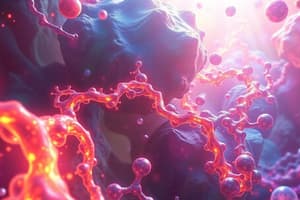Podcast
Questions and Answers
What is the primary component that makes up carbohydrates?
What is the primary component that makes up carbohydrates?
- Carbon, hydrogen, and oxygen (correct)
- Nitrogen and oxygen
- Phosphorus and sulfur
- Calcium and magnesium
Which of the following is classified as a six-carbon sugar?
Which of the following is classified as a six-carbon sugar?
- Ribose
- Glyceraldehyde
- Glucose (correct)
- Starch
What is one of the main functions of carbohydrates?
What is one of the main functions of carbohydrates?
- Synthesis of proteins
- Energy production and storage (correct)
- Storage of oxygen
- Regulation of genetic information
Sugars typically end with which suffix?
Sugars typically end with which suffix?
In a solution, hexose and pentose sugars tend to form what type of structure?
In a solution, hexose and pentose sugars tend to form what type of structure?
What is the primary role of isoleucine in the feedback inhibition process described?
What is the primary role of isoleucine in the feedback inhibition process described?
How does feedback inhibition affect the active site of enzyme 1?
How does feedback inhibition affect the active site of enzyme 1?
In the context of enzyme regulation, which term accurately describes the process of creating larger molecules from smaller ones?
In the context of enzyme regulation, which term accurately describes the process of creating larger molecules from smaller ones?
What is implied about intermediate C in the enzyme pathway?
What is implied about intermediate C in the enzyme pathway?
Which statement is true regarding the induced fit model of enzyme action?
Which statement is true regarding the induced fit model of enzyme action?
What is the consequence of the active site of enzyme 1 being unable to bind to threonine?
What is the consequence of the active site of enzyme 1 being unable to bind to threonine?
What type of reaction would you observe when converting threonine to isoleucine in the described process?
What type of reaction would you observe when converting threonine to isoleucine in the described process?
What role do intermediate products play in enzyme regulation?
What role do intermediate products play in enzyme regulation?
Which type of amino acid has R groups that accept H+ ions?
Which type of amino acid has R groups that accept H+ ions?
What is the primary structure of a protein defined by?
What is the primary structure of a protein defined by?
Which process results in the formation of peptide bonds?
Which process results in the formation of peptide bonds?
Which level of protein structure involves coiling and folding brought about by hydrogen bonds?
Which level of protein structure involves coiling and folding brought about by hydrogen bonds?
What effect does denaturation have on proteins?
What effect does denaturation have on proteins?
What role do chaperone proteins play in protein synthesis?
What role do chaperone proteins play in protein synthesis?
Which interactions contribute to the tertiary structure of a protein?
Which interactions contribute to the tertiary structure of a protein?
Which of the following statements about acidic amino acids is true?
Which of the following statements about acidic amino acids is true?
What is the effect of temperature on enzyme function?
What is the effect of temperature on enzyme function?
Which of the following factors can denature an enzyme?
Which of the following factors can denature an enzyme?
What role do cofactors play in enzyme activity?
What role do cofactors play in enzyme activity?
What is the relationship between enzyme concentration and enzyme activity?
What is the relationship between enzyme concentration and enzyme activity?
What are coenzymes primarily composed of?
What are coenzymes primarily composed of?
Which pH level is optimal for pepsin, the stomach enzyme?
Which pH level is optimal for pepsin, the stomach enzyme?
What happens when an enzyme is denatured?
What happens when an enzyme is denatured?
What can result from a lack of optimal enzyme concentration in a reaction?
What can result from a lack of optimal enzyme concentration in a reaction?
What is the primary reason carnivores do not digest cellulose effectively?
What is the primary reason carnivores do not digest cellulose effectively?
Which organism is primarily reliant on bacteria to aid digestion of cellulose?
Which organism is primarily reliant on bacteria to aid digestion of cellulose?
What is the chemical formula for glucose?
What is the chemical formula for glucose?
What percentage of a healthy diet should consist of complex carbohydrates or starches?
What percentage of a healthy diet should consist of complex carbohydrates or starches?
Which of the following is NOT a type of carbohydrate?
Which of the following is NOT a type of carbohydrate?
What role do helpful bacteria play in herbivores' digestion?
What role do helpful bacteria play in herbivores' digestion?
Which source provides simple carbohydrates that should be avoided?
Which source provides simple carbohydrates that should be avoided?
What type of carbohydrate is cellulose classified as?
What type of carbohydrate is cellulose classified as?
Flashcards are hidden until you start studying
Study Notes
Enzyme Action and Factors Influencing Reactions
- Enzymes act on substrates at the active site, forming an enzyme-substrate complex.
- Reaction rate is quantified by substrate conversion to product per minute, influenced by various factors.
- Environmental factors (temperature and pH) significantly affect enzyme activity.
- Cofactors (inorganic) and coenzymes (organic) assist enzymes in catalytic processes.
- Enzyme and substrate concentrations affect active site saturation and overall reaction rate.
- Inhibitors can impede enzyme activity, impacting the reaction rate.
Effects of Temperature and pH
- Each enzyme has an optimal temperature range for activity, with variations between human enzymes and thermophilic (heat-tolerant) bacteria.
- Each enzyme also has an optimal pH; e.g., pepsin functions best in acidic environments, while trypsin thrives in more neutral conditions.
- Beyond optimal conditions, enzymes may denature, losing their functional shape and activity.
Allosteric Regulation and Feedback Inhibition
- Allosteric sites on enzymes can bind inhibitors or activators, influencing enzyme function.
- Feedback inhibition occurs when products of a metabolic pathway inhibit early steps, regulating the overall production of end products.
Carbohydrate Structure and Function
- Carbohydrates are composed of carbon, hydrogen, and oxygen (general formula CH2O).
- Primary functions include providing fast energy, energy storage, and serving as structural materials.
- Monomer units of carbohydrates are sugars; examples include glucose, fructose, and galactose.
- Sugars are classified by carbon number: hexoses (6C) like glucose, pentoses (5C) like ribose, and trioses (3C) like glyceraldehyde.
Cellulose and Digestion
- Cellulose, a major organic compound, is indigestible for many organisms except specific herbivores equipped with special bacteria in their gut.
- Herbivores rely on these microbes to process cellulose, while carnivores do not have the requisite enzymes for cellulose digestion.
Nutritional Aspects of Carbohydrates
- Carbohydrates serve as the primary energy source for organisms, found in foods like pasta, rice, and potatoes.
- The chemical structure of glucose is C6H12O6, with a hydrogen-to-carbon-to-oxygen ratio of 1:2:1.
- A healthy diet should include at least 40% complex carbohydrates, with caution advised for simple sugars.
Amino Acids Classification
- Amino acids are categorized based on the nature of their R groups: nonpolar (hydrophobic), polar (hydrophilic), acidic, and basic.
- Acidic amino acids donate H+ and carry a negative charge, while basic amino acids accept H+ and are positively charged.
Protein Structure and Formation
- Proteins are polymers of amino acids linked via peptide bonds through dehydration synthesis.
- Structure levels: Primary (amino acid sequence), Secondary (coiling and folding due to hydrogen bonds), Tertiary (3D folding from various interactions), Quaternary (multiple polypeptide chains together).
- Denaturing agents like temperature changes disrupt the 3D structures but some proteins can return to functional form.
Role of Chaperone Proteins
- Chaperone proteins facilitate correct protein folding, providing a protected environment during the folding process to prevent misfolding.
Significance of Chemistry in Biology
- Understanding the chemistry of life, including reactions involving carbohydrates, proteins, and enzymes, is critical for studying biological processes and functions.
Studying That Suits You
Use AI to generate personalized quizzes and flashcards to suit your learning preferences.




